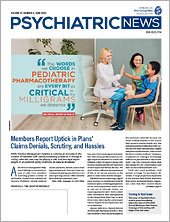Our nation’s youth are experiencing a severe mental health crisis. We are increasingly seeing, both in our practices and in newly released data, that the pandemic has taken a severe toll on our children and adolescents. Yet the pandemic has only worsened what was already a troubling trend: As of 2018, suicide was the second leading cause of death for youth aged 10 to 24.
The best way to broach the topic of suicide and truly ascertain whether our youth are having suicidal thoughts is to ask them. Yet, in recent draft recommendations, the U.S. Preventive Task Force (USPTF) concluded that there is not enough evidence-based research to recommend for or against screening for suicide among youth who are not already showing signs or symptoms of anxiety, depression, or suicide. (The comment period on the draft recommendations closed May 9; according to its website, USPTF will consider all comments while writing the final recommendations.)
Eliminating universal screening for suicide among youth aged 12 and older would be a dangerous mistake. Now, in the shadow of the pandemic, is the time to encourage families to talk about mental illness and suicide, not to sweep those conversations under the rug. We cannot erase the stigma around mental illness without asking questions and having difficult conversations. Asking youth if they or one of their friends have ever had suicidal thoughts gives them the opportunity to share feelings that they may have kept hidden out of fear and shame. For some, directly being asked about suicide could be the only avenue they have to talk about their thoughts and experiences.
We should avoid over screening youth, and physicians should use their discretion when deciding to screen children aged 7 to 11. But we are currently seeing disturbing trends that suggest more screenings may be necessary, not fewer. In a study published in the May Journal of the American Academy of Child & Adolescent Psychiatry, Arielle Sheftall, Ph.D., and colleagues found that, from 2003 to 2017, the rate of suicide among Black youth increased every year across all age groups. The greatest increase was among Black youth aged 15 to 17, followed by those aged 5 to 11 years. The rate of suicide among Black girls increased annually at 6.6%, which was more than twice the rate among Black boys. We cannot hope to understand what is causing this devastating increase in suicides among Black children without screening this population. We may be able to halt this increase and gather vital data through utilization of screening tools for this specific population, particularly Black girls.
Research indicates that many people who die by suicide had an encounter with a medical professional in the weeks or months before their death. By incorporating suicide screenings into routine health care, we can both catch youth in need who may not have any other outlet for expressing their thoughts and chip away at the enormous mental health stigma still pervading our society.
Ensuring youth are routinely screened is only one important part of reducing the rate of youth suicide. Primary care providers must have the resources necessary to connect youth to quality mental health care when they screen positive for suicide risk. Integrated, collaborative primary and mental health care is an evidence-based method that allows families to seamlessly access the care their children need. Additionally, integrating a social-emotional health curriculum in schools beginning in kindergarten can assist with normalizing mental health issues for both children and families and assist with erasing stigma. Further, our mental health care system is on the precipice of a major shift with the implementation of 988 as the nationwide, three-digit dialing code for people experiencing a mental health crisis. This provides an opportunity to direct funding specifically toward youth mental health.
There is a dangerous misconception among the public that talking about suicide will only encourage suicidal thoughts or behaviors. In my clinical experience working with children, adolescents, and their families, I have seen many suicides prevented because the patients were simply asked if they were having thoughts of “not wanting to be here.” And I have also, unfortunately, seen suicides completed because no one said anything, and no one asked.
The increase of suicides among our youth is tragic. We are not without options to address the problem. We must show our youth that there are adults around them with whom they can have safe conversations about these thoughts. We must ask them these difficult questions. ■

